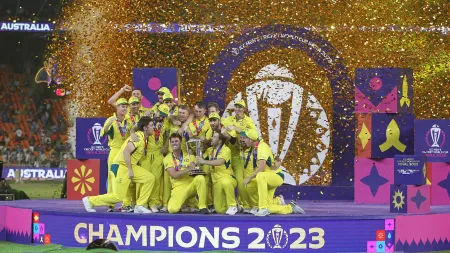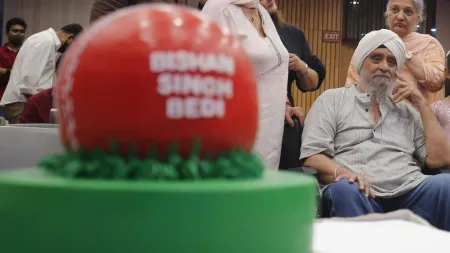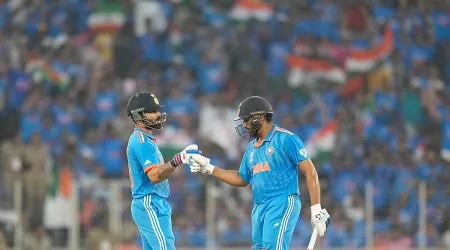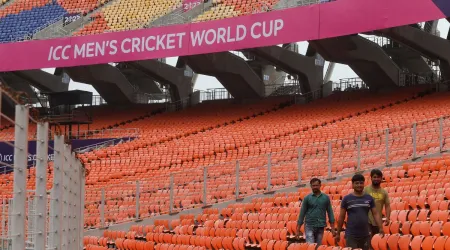- India
- International
Obstacle race: Faster, Higher, Stronger stories
India's athletes will not only have to conquer a strong field but also their demons to succeed at Asian Games.
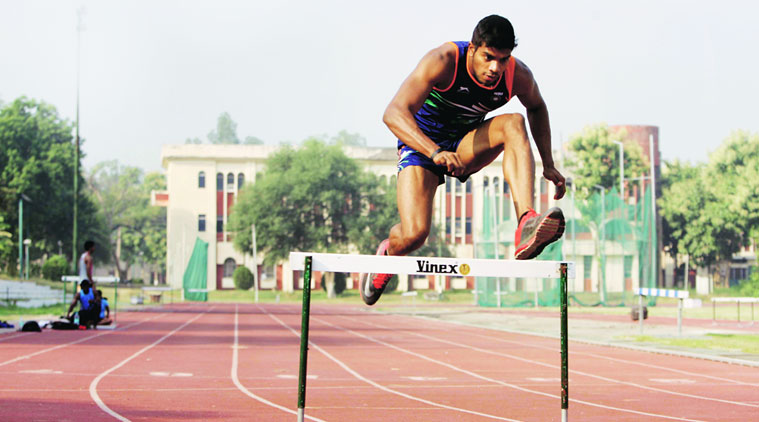 Ace hurdler Siddhanth Thingalaya (Source: Express Photo)
Ace hurdler Siddhanth Thingalaya (Source: Express Photo)
Siddhanth Thingalaya crouched at the starting blocks of Lane 4 of the worn-out athletics track at NIS, Patiala. The finish line was in his sights, even if slightly blurred by the maze of hurdles in front of him. But his mind was elsewhere, with a slew of unpleasant thoughts clouding it.
That he would win the race was a foregone conclusion. Whenever he runs in the country, the clock perched adjacent to the finish line is his only opponent. However, India’s No.1 hurdler was going through one of the darkest phases of his career before he took his position at the starting line of the Federation Cup last month, which doubled up as the trials for Asian Games.
Just a fortnight ago, Thingalaya had clocked an embarrassing 13.93 seconds against a strong head-wind at the Glasgow Commonwealth Games. Running from the outside lane in a Heat where his timing was the worst among the eight runners, the 23-year-old managed to finish third but failed to qualify for the final. “Horror. It was the worst race of my career,” Thingalaya grimaces.
The spate of injuries he has suffered too had sapped his confidence. Three hamstring injuries in the last two years resulted in him spending more time fighting the demons in his head; spending more time in rehab than racing.
Even when he was in the USA training under renowned coach Darrel Smith, Thingalaya had pulled his hamstring. He spent a major part of his time in California learning to shave off a few seconds from his below-par performances, and to remain healthy. With a refined technique and relatively reliable hamstring, he returned to the venue where he first burst onto the scene four years ago, feeling reassured.

Whatever little insecurity remained within him vanished the moment the gun went off. Thingalaya crossed the line in 13.65secs, equalling his own national record. Significantly, he did so without clipping a hurdle. “It was as clean a race as I could hope for. And it was crucial to get that timing. Now I can move forward,” Thingalaya says.
The ‘moving forward’ bit should ideally have started two years ago when he first clocked 13.65secs (at the Belgian National Championship in Brussels, 2012). Or maybe even before.
The journey wasn’t meant to pan out like this for the Mumbai lad. When he broke the national record for the first time, Thingalaya was just 19.
The 13.81secs he clocked to eclipse K Krishna Mohan’s national record in Patiala held a lot of promise for the future. “But my technique was all wrong. I used to have a weird action and I had to do a lot of unlearning to harbour hopes of reducing my personal best,” the 6’3” tall runner says.
There were two key issues that demanded attention — rhythm and fitness. Thingalaya’s childhood coach Ajit Kulkarni says the first challenge was to ensure he gets quickly off the blocks. A two-year stint between 2011 and 2013 in Australia under coach Sharon Hannon came at the right time. In Brisbane, Thingalaya trained with sprinters to improve his starts. He took mental notes of what the likes of Australian champion Sally Pearson — who trained at the same centre — did and tried to replicate it.
“I even realised that to explode from the blocks, your glutes need to be powerful and hamstring and calf muscles need to be strong. I started working on those things,” Thingalaya says. “Executing and maintaining the rhythm is key. If I have made mistake in the first hurdle, then I have nine others to correct it so that other athletes don’t go past me.”
It is during this period that his hamstring started acting up. Just before the Diamond League meet in Birmingham last year, he suffered a hamstring injury on his left leg — his leading leg. He had to lay low for a while and within months of his return, the issue resurfaced. After missing out on Olympic qualification because of the injury he sustained, Thingalaya clocked 13.88secs, 13.90secs and 13.81secs in the Asian Grand Prix series, winning silver, bronze and gold, respectively.
But the medals were a mere consolation. His timings had come down drastically, meaning he had to virtually start from scratch again. “I need to strengthen my back. I also have a tendency that my calf gets tight whenever I work out. I need to ensure calf is relaxed so that it doesn’t affect my hamstring again,” he says.
While Hannon worked on strengthening his core and improving his starts, Thingalaya says his most-recent stint in California under Smith was to improve his rhythm. The 23-year-old has a tendency of clocking world-class times for the first five hurdles. He, in fact, clocks an average of 6.22secs in the first half of the race, which is comparable to world’s best. However, he loses the steam in the latter stages.
His opponents have figured this out and even exploited this flaw in his technique repeatedly. “They catch me after the fifth hurdle because they know I get slower and slower after that. Now, my thing is to run away from these guys. It will take time but it is not impossible,” he accepts.
World Championship silver medallist Ryan Wilson, his training partner, advised him to stand tall while running. Boasting of long strides, Thingalaya lost milliseconds by bending his knee a little extra and keeping his tail either too low or too high, instead of keeping it close to the hurdles. The changes in his running style are still a work in progress, with Thingalaya leaving it for the off-season.
Not surprisingly, he isn’t entirely satisfied with his preparations for the Asian Games, insisting that ‘there is still a lot of room for improvement.’ A medal may not be out of grasps for the youngster but it certainly won’t come easy.
To finish on the podium, Thingalaya may well have to better the national record yet again. His 13.65secs effort in Patiala is the fifth-fastest timing in Asia this year. Chinese Xie Wenjun is at the top with 13.23secs followed by Kuwait’s Mandeel Abdulaziz (13.56secs) and two Japanese athletes, Masund Genta (13.58secs) and Yazawa Wataru (13.59secs). South Korea’s Jung-Joon Lee has clocked the same time as Thingalaya.
The hurdler feels it is achievable. He insists the timing in Patiala could have been better had he not landed flat after clearing the ‘seventh or eighth’ hurdle. “But I feel I can run below 13.60 secs in Incheon and that should hopefully put me in medal contention in Asian Games. Tough, yes, but not impossible,” he says.
High jumper has to clear NR just to be competitive
 Nikhil Chittarasu
Nikhil Chittarasu
When he cleared the bar set at 2.21 metres at the Federation Cup in Patiala last month, Nikhil Chittarasu had done more than just create a new meet record. The mark was also a personal best for the Tamil Nadu jumper and would have been enough to have won him a bronze medal at the 2010 Asian Games.
The ease with which he cleared the mark (he didn’t foul once until that point) indicated he had the ability to leap even higher. However Chittarasu failed in each of his three attempts of 2.26m that would have given him the national record. The jumper blamed nerves that saw him make a basic error (he leaned far too early in his jump).
There will be little chance for excuses at the Asian Games however. Unless he clears the national mark at Incheon, however, Chittarasu seemingly has little chance to make a mark. Qatar’s Mutaz Essa Barshim will likely be the one to defend his title from 2010. Last week Barshim, 23, leaped 2.43m to record the second highest jump of all time. Apart from Barshim, Gouwei Zhang of China and Naoto Tobe of Japan have cleared 2.30m this year. And another six Asian athletes have cleared 2.26m this year.
Triple jumper Arpinder leads Asia in 2014
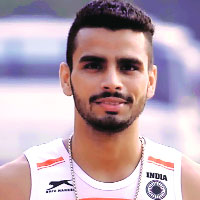 Arpinder Singh
Arpinder Singh
21-year-old Triple jumper Arpinder Singh first came into the limelight at Lucknow’s Inter State Athletics Championships this year, when he leaped 17.17m to break Renjith Maheshwary’s four year old national mark of 17.05m. Arpinder subsequently won a bronze medal at the Commonwealth Games last month. While the medal was achieved, Arpinder’s personal goal — a jump beyond 17.35m would prove unacheivable. However, in rainy conditions in Glasgow, he only managed a jump of 16.63m. Still, at the upcoming Asian Games, Arpinder has one of the best chances of any Indian track-and-field athlete on the basis of this year’s performances. Even the Indian’s sub-par leap at Glasgow is the third best by any Asian competitor this year.
His winning jump of 16.70m at the Federation Cup last month is the second best at the Asian level this year. Indeed no one else from the continent has managed to clear the 17m mark yet in 2014 (China’s Zhuo Cao is the next best with a leap of 16.88m). However, Zhuo cannot be dismissed altogether. He has a personal best of 17.35m and only last year cleared 17.26m.
Strong field means no walkover for racewalkers
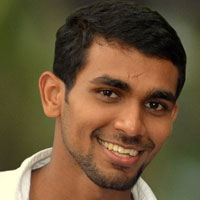 K T Irfan
K T Irfan
KT Irfan, who finished 10th in the 20km racewalk event at the 2012 Olympics, will lead the Indian racewalking contingent in Incheon this year.
While Irfan was always expected to make the cut, the omission of Gurmeet Singh was surprising. The latter had infact won a bronze medal at the Asian Racewalking Championships in Nomi, Japan, earlier this year and had medalled at the event for the last three years. However, Gurmeet had returned a substandard time at the Federation Cup last month. While racewalking is seen as a new hope for Indian athletics, the recent results suggest that other Asian nations will not prove to be a walkover. At the racewalking World Cup in Taicang in May this year, nine Asian participants finished ahead of Irfan who was the best placed Indian. In all competitions in 2014, seven competitors from Asian countries have recorded a time better than Irfan’s national record of 1:20:21 set at the London Olympics.
Among the women Khushbir Kaur has a bronze medal from the Asian Racewalking championships. And while Kaur set a national record of 1:31:40 at the World Cup, that mark only places her 15th at the Asian level. And the 14 better times are all set by participants from China. With only two athletes from each country permitted to take part at the Games, Kaur still has an outside chance to bag a medal.




















